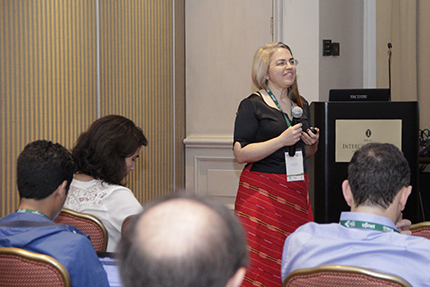 For the first time since its inception TICAL has shared its program and headquarters with another event: the 1st Latin American e-Science Meeting, organized by the BELLA-T Project. The initiative sought to offer a new space for the exchange of knowledge and good practices in the use of Information and Communication Technologies (ICT) in research work, aiming to contribute to the improvement and optimization of the management and work of the scientific communities in the region.
For the first time since its inception TICAL has shared its program and headquarters with another event: the 1st Latin American e-Science Meeting, organized by the BELLA-T Project. The initiative sought to offer a new space for the exchange of knowledge and good practices in the use of Information and Communication Technologies (ICT) in research work, aiming to contribute to the improvement and optimization of the management and work of the scientific communities in the region.
It was with this objective that the Meeting had an open call for Latin American researchers to present papers exposing their experiences in the development of collaborative initiatives involving the use of ICTs in the areas of Biodiversity, eHealth, Environment, Astronomy, Networked Art andCulture, and High Energy Physics. The call was successful and paved the way for the development of the event that took place between July 3 and 5, in San José, Costa Rica.
"We got 93 proposals from 14 countries, and we chose 18 works. During the sessions, the discussion spaces were fruitful and we are now working on the outcome of those interactions. The groups proposed carrying out informative days, systematizing experiences and a discussion that we are planning for November. In addition, in the evaluations of the conference the responses reflected the perception of the activity where rated 51% as Excellent, 30% as Very good and 9% as good", says Tania Altamirano, General Coordinator of Communities of RedCLARA and one of the organizers of the event.
For Altamirano, the meeting met the expected objective, allowing the interaction of scientists from the selected areas with their peers and with researchers of other areas. "That is one of the most important results, because it allowed us to identify transversal lines of work for future activities", she said.
A good example of such interaction is the creation of new communities such as "eScience + eArts". "It is a multidisciplinary and transnational group that is already working and has very promising initiatives", says Delma Rodriguez, representative of Anilla Cultural Latin America-Europe in Uruguay, who presented “Red Amigos del CERN Latinoamérica y El Caribe”. For her, having the e-Science Meeting in parallel with TICAL2017 was very clever. "My participation is already generating a lot of synergies. In particular, the proposal I presented constituted an important legitimation, along with the opening to new and wide horizons for the network of friends, with the aim of scientific dissemination and specially in particle physics", she explains.
A second edition of the Meeting is not ruled out, but according to Tania Altamirano, the idea now is to continue with the activities planned by the groups. "Of course there could be a next edition, but we are currently focused in strengthening the presented initiatives."
For more information and to download all the presentations of the 1st Latin American e-Science Meeting visit https://eventos.redclara.net/indico/event/788/.
The BELLA (Building Europe Link to Latin America) project aims to achieve a significant long-term improvement of the network in South America - RedCLARA -, allowing the national networks of Latin America and the research groups that integrate them, direct and high speed access to the capacities offered by the submarine cable that will be installed between Europe and the region.



